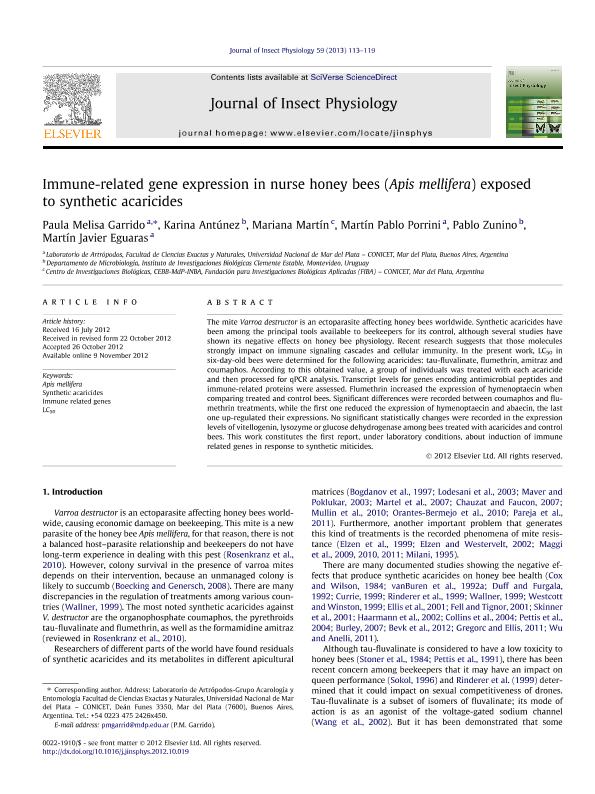Mostrar el registro sencillo del ítem
dc.contributor.author
Garrido, Paula Melisa

dc.contributor.author
Antúnez, Karina
dc.contributor.author
Martin, Mariana Laura

dc.contributor.author
Porrini, Martín Pablo

dc.contributor.author
Zunino, Pablo
dc.contributor.author
Eguaras, Martin Javier

dc.date.available
2017-09-26T17:59:33Z
dc.date.issued
2013-02
dc.identifier.citation
Garrido, Paula Melisa; Antúnez, Karina; Martin, Mariana Laura; Porrini, Martín Pablo; Zunino, Pablo; et al.; Immune-related gene expression in nurse honey bees (Apis mellifera) exposed
to synthetic acaricides; Pergamon-Elsevier Science Ltd.; Journal of Insect Physiology; 59; 1; 2-2013; 113-119
dc.identifier.issn
0022-1910
dc.identifier.uri
http://hdl.handle.net/11336/25140
dc.description.abstract
The mite Varroa destructor is an ectoparasite affecting honey bees worldwide. Synthetic acaricides have been among the principal tools available to beekeepers for its control, although several studies have shown its negative effects on honey bee physiology. Recent research suggests that those molecules strongly impact on immune signaling cascades and cellular immunity. In the present work, LC50 in six-day-old bees were determined for the following acaricides: tau-fluvalinate, flumethrin, amitraz and coumaphos. According to this obtained value, a group of individuals was treated with each acaricide and then processed for qPCR analysis. Transcript levels for genes encoding antimicrobial peptides and immune-related proteins were assessed. Flumethrin increased the expression of hymenoptaecin when comparing treated and control bees. Significant differences were recorded between coumaphos and flumethrin treatments, while the first one reduced the expression of hymenoptaecin and abaecin, the last one up-regulated their expressions. No significant statistically changes were recorded in the expression levels of vitellogenin, lysozyme or glucose dehydrogenase among bees treated with acaricides and control bees. This work constitutes the first report, under laboratory conditions, about induction of immune related genes in response to synthetic miticides.
dc.format
application/pdf
dc.language.iso
eng
dc.publisher
Pergamon-Elsevier Science Ltd.

dc.rights
info:eu-repo/semantics/openAccess
dc.rights.uri
https://creativecommons.org/licenses/by-nc-sa/2.5/ar/
dc.subject
Apis Mellifera
dc.subject
Synthetic Acaricides
dc.subject
Immune Related Genes
dc.subject
Lc50
dc.subject.classification
Bioquímica y Biología Molecular

dc.subject.classification
Ciencias Biológicas

dc.subject.classification
CIENCIAS NATURALES Y EXACTAS

dc.title
Immune-related gene expression in nurse honey bees (Apis mellifera) exposed
to synthetic acaricides
dc.type
info:eu-repo/semantics/article
dc.type
info:ar-repo/semantics/artículo
dc.type
info:eu-repo/semantics/publishedVersion
dc.date.updated
2017-09-21T18:01:19Z
dc.journal.volume
59
dc.journal.number
1
dc.journal.pagination
113-119
dc.journal.pais
Estados Unidos

dc.journal.ciudad
New York
dc.description.fil
Fil: Garrido, Paula Melisa. Universidad Nacional de Mar del Plata. Facultad de Ciencias Exactas y Naturales; Argentina
dc.description.fil
Fil: Antúnez, Karina. Instituto de Investigaciones Biológicas "Clemente Estable"; Uruguay
dc.description.fil
Fil: Martin, Mariana Laura. Fundación para Investigaciones Biológicas Aplicadas; Argentina. Consejo Nacional de Investigaciones Científicas y Técnicas; Argentina
dc.description.fil
Fil: Porrini, Martín Pablo. Universidad Nacional de Mar del Plata. Facultad de Ciencias Exactas y Naturales; Argentina
dc.description.fil
Fil: Zunino, Pablo. Instituto de Investigaciones Biológicas "Clemente Estable"; Uruguay
dc.description.fil
Fil: Eguaras, Martin Javier. Universidad Nacional de Mar del Plata. Facultad de Ciencias Exactas y Naturales; Argentina
dc.journal.title
Journal of Insect Physiology

dc.relation.alternativeid
info:eu-repo/semantics/altIdentifier/doi/http://dx.doi.org/10.1016/j.jinsphys.2012.10.019
dc.relation.alternativeid
info:eu-repo/semantics/altIdentifier/url/http://www.sciencedirect.com/science/article/pii/S0022191012002727
Archivos asociados
